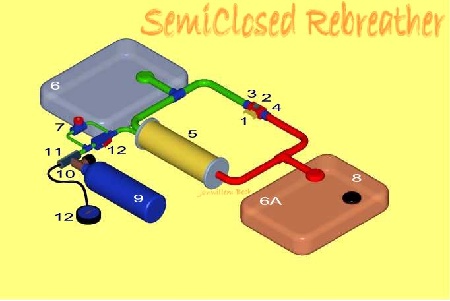
 |
Schematic parts of the SCR
1. Mouthpiece |
|
Nitrox is being brought in the loop via a constant flow injector (commonly a orifice) from a Nitrox cylinder. The gas can expand in the counter lung(s) and thus becomes available to the diver. By making use of one way valves the gas flow is being forced through the scrubber. The gas flows continuously into the loop. The diver uses up oxygen and produces CO2 as waste gas. As the diver gets deeper the partial oxygen pressure will increase, the fraction though will stay alike. Because the number of litres of gas that is being added is being determined by the nozzle, this will probably be installed in such a way that the diver will be provided with sufficient (if the rebreather is well designed) oxygen. The consumption though depends on the divers exertion. However, even at maximum exertion oxygen will (should) be supplied sufficiently. This will cause a small amount of breathing gas to escape via the overpressure valve every 4 to 5 gasps of air. Since the diver has a varying use of oxygen during the dive, and since there is a variation in the speed in the loop, a different fraction is breathed then the fraction in de cylinder. This necessitates to calculate the fraction that is being inhaled in order to define the nitrogen uptake. The calculations of MOD and CNS are based upon the fraction of the gas in the cylinder. To calculate the actual fraction inhaled by the diver:
Further details about calculations with a SC
rebreather can be found
here. Note: The oxygen used by a diver has no relation to
the ambient pressure. The variation is only related to factors as
exertion, stress, condition, design of the rebreather. There are certain
situations that the diver has to manually add gas. Therefore a SC
rebreather should always have a manual bypass! |
|